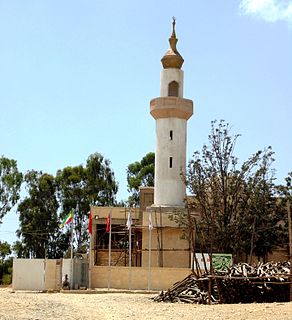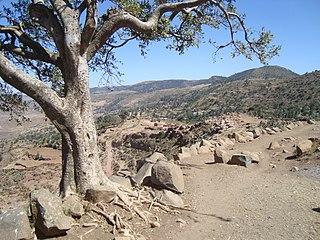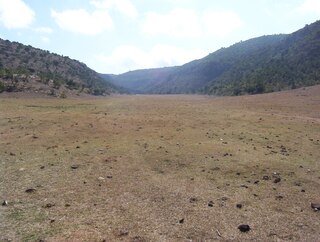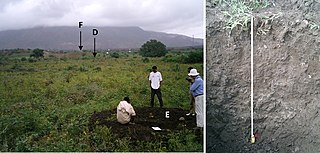History
Mordechai Abir notes that, along with Ficho, Atsbi was an important center of trade in the blocks of salt called amoleh , which was used as late as the 20th century as currency. Both settlements lay on the borders of the former provinces of Agame and Enderta at the edge of the Ethiopian highlands. [1] Here caravans brought thousands of amolahs from the salt deposits in the Afar Depression, which were then sold to traders for about 100 to one Maria Theresa Thaler; these merchants then transported the blocks west to Adwa, Axum and Gondar, and south to Gojjam and beyond as far as Ennarea and the Kingdom of Kaffa where they sold them at a profit. [2]
The Italians occupied Atsbi on 12 November 1935, after clashing with the troops of Dejazmach Kassa Sebhat. [3]
In 1938, there was a health post and a telephone office. [4]
The Italian army left the town in 1941.
The refugee camp at Atsbi, along with the one at Korem, were shown on BBC television on 23 and 24 October 1984 as an example of the devastation of the 1983–85 famine. [5]

Negash is a village in the Tigray Region of Ethiopia, which straddles the Adigrat-Mekele road 10 kilometres north of Wukro. Located in Wukro woreda.
Edaga Hamus is a town in northern Ethiopia. Located 97 kilometers north of Mekele in the Misraqawi Zone of the Tigray Region of Ethiopia, this town has a latitude and longitude of 14°11′N39°34′E with an elevation of approximately 2700 meters above sea level. At this elevation, it is one of the highest towns of this size in the Tigray Region. Idaga Hamus is located on "National Road 1", between Freweyni and Adigrat.

Chalacot or Chelekot is a village in the Tigray Region of Ethiopia. Located in the Enderta woreda of the Debub Misraqawi (Southeastern) Zone, 10 kilometers north of Antalo and 17 kilometers south of Mek'ele, the village has a latitude and longitude of 13°22′N39°28′E with an approximate elevation of 2100 meters above sea level. The Central Statistical Agency has not published an estimate for this village's 2005 population.

Agula is a town located in northern Ethiopia. Located in the Debubawi (Southern) Zone of the Tigray Region, it lies about 32 km northeast of Mek'ele, just east of the Mek'ele - Addis Ababa highway, and 25 km north of Qwiha. It has a latitude and longitude of 13°41′30″N39°35′30″E with an elevation of 1930 metres above sea level. Nearby is a stream and a pass which share the same name.

Freweyni is a town in northern Ethiopia. Located 80 kilometers north of Mekele in the Misraqawi Zone of the Tigray Region of Ethiopia, this town has a latitude and longitude of 14°3′N39°34′E with an elevation of 2480 meters above sea level and is located along Ethiopian Highway 2.

Maimekden is a village in Tigray Region, located 27 kilometers south of Wukro. It is located on the crossing of Ethiopian Highway 2 and the Mai Mekden river, flowing west to the Geba River.

Mika’el Abiy is a tabia or municipality in the Dogu’a Tembien district of the Tigray Region of Ethiopia. The tabia centre is in Megesta village, located approx. 7 km to the southeast of the woreda town Hagere Selam.

Melfa is a tabia or municipality in the Dogu'a Tembien district of the Tigray Region of Ethiopia and ancient capital of Tembien. The tabia centre is Melfa village itself, located approximately 3 km to the west of the woreda town Hagere Selam.

Aregen is a tabia or municipality in the Dogu'a Tembien district of the Tigray Region of Ethiopia. The tabia centre is in Addi Gotet village, located approximately 11 km (6.8 mi) to the west-southwest of the woreda town Hagere Selam.

Menachek is a tabia or municipality in the Dogu'a Tembien district of the Tigray Region of Ethiopia. The tabia centre is in Addi Bayro village, located approximately 12 km to the southwest of the woreda town Hagere Selam.

Mizan is a tabia or municipality in the Dogu'a Tembien district of the Tigray Region of Ethiopia. This tabia includes the rock church of Debre Sema'it, as well as Arefa, reputedly birthplace of the Queen of Sheba. The tabia centre is in Kerene village, located approximately 16 km to the southwest of the woreda town Hagere Selam.

Simret is a tabia or municipality in the Dogu'a Tembien district of the Tigray Region of Ethiopia, which comprises the longest cave of Tigray in Zeyi, as well as Ras Alula’s birthplace in Mennewe. The tabia centre is in Dengolo village, located approximately 12 km to the southwest of the woreda town Hagere Selam.

Selam is a tabia or municipality in the Dogu'a Tembien district of the Tigray Region of Ethiopia. The tabia centre is in Addi Werho village, located approximately 3 km to the northeast of the woreda town Hagere Selam.

The soils of the Kilte Awula’ilo woreda (district) in Tigray reflect its longstanding agricultural history, highly seasonal rainfall regime, relatively low temperatures, the presence of a wide depression at the foot of the Atsbi horst and steep slopes. Outstanding features in the soilscape are the wide ancient fluvial deposits, the soils of the granite batholith, cuestas and fertile lands behind tufa dams.

The soils of the Atsbi Wenberta woreda (district) in Tigray (Ethiopia) reflect its longstanding agricultural history, highly seasonal rainfall regime and relatively low temperatures. The northern part of the district is on the high uplifted Atsbi Horst, whereas the southern part is dominated by the Des’a forest on Antalo Limestone. In between there is the fluvial landscape of Hayqi Meshal. Particularities in the southern part of the district are soil catenas on intervening plains behind tufa dams and in a polje.

The soils of the Sa'isi Tsa'ida Imba woreda (district) in Tigray (Ethiopia) reflect its longstanding agricultural history, highly seasonal rainfall regime, relatively low temperatures, overall dominance of metamorphic and sandstone lithology and steep slopes.
The soils of the Inderta woreda (district) in Tigray (Ethiopia) reflect its longstanding agricultural history, highly seasonal rainfall regime, relatively low temperatures, overall dominance of limestone and dolerite lithologies and steep slopes. Outstanding features in the soilscape are wide plains with Vertisols.

The soils of the Tanqwa Abergele woreda (district) in Tigray (Ethiopia) reflect its longstanding agricultural history, highly seasonal rainfall regime, relatively high temperatures, overall dominance of Precambrian metamorphic rocks and steep slopes.

The soils of the Kola Tembien woreda (district) in Tigray (Ethiopia) reflect its longstanding agricultural history, highly seasonal rainfall regime, relatively high temperatures, overall dominance of sandstone and metamorphic lithology and steep slopes.

The soils of the Dogu’a Tembien woreda (district) in Tigray (Ethiopia) reflect its longstanding agricultural history, highly seasonal rainfall regime, relatively low temperatures, an extremely great variety in lithology and steep slopes. Outstanding features in the soilscape are the fertile highland Vertisols and Phaeozems in forests.





















